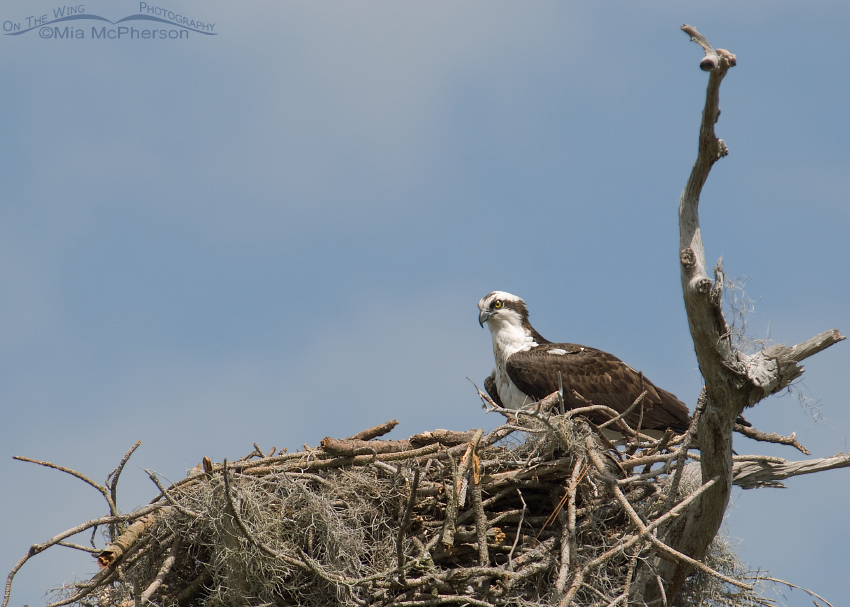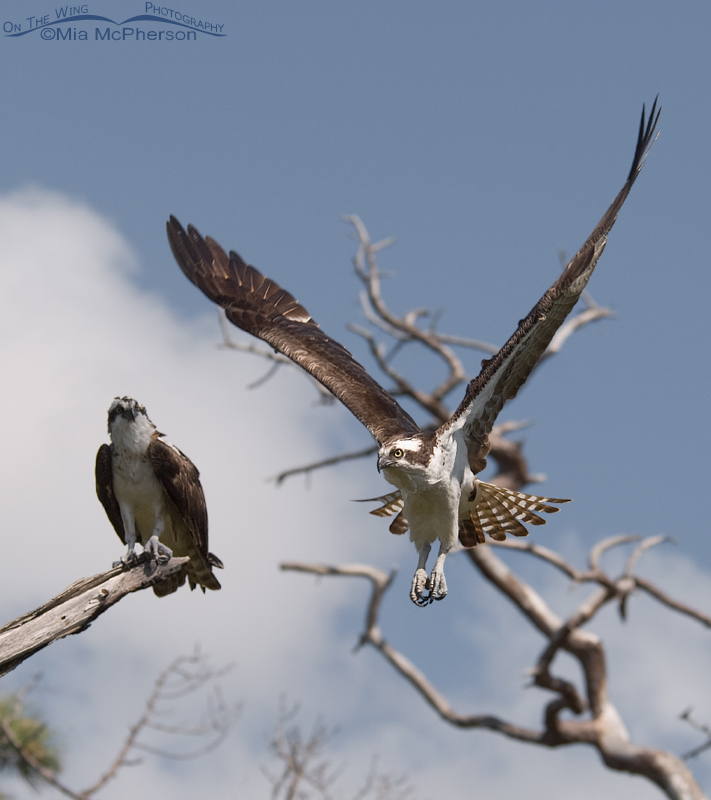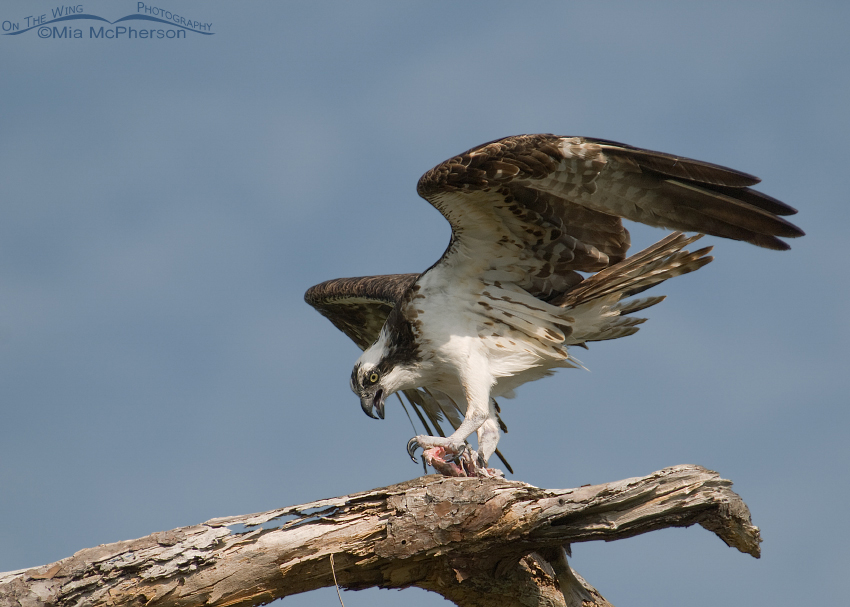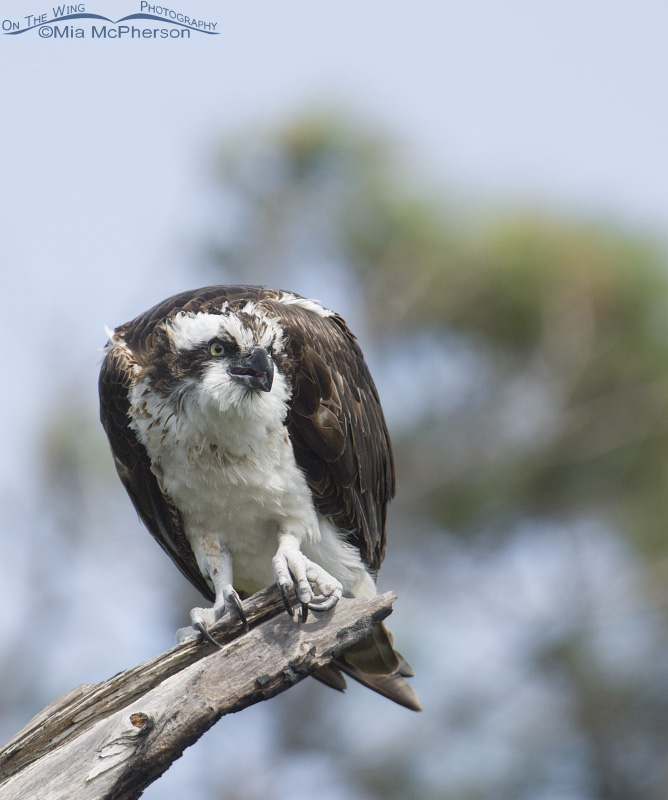The month of April reminds me that the Ospreys in Florida have already started their nesting season and that by now most of them have chicks that they are busy feeding.
 Osprey on nest on Honeymoon Island – Nikon D200, handheld, f6.3, 1/1000, ISO 200, Nikkor 80-400mm VR at 400mm, natural light, not baited
Osprey on nest on Honeymoon Island – Nikon D200, handheld, f6.3, 1/1000, ISO 200, Nikkor 80-400mm VR at 400mm, natural light, not baited
I see Ospreys in Utah but not with the frequency or ease that I experienced while I lived in Florida, here in Utah the Ospreys seem to prefer high mountains lakes, reservoirs or rivers to nest close to and I don’t see them all that often down here in the valley.
Honeymoon Island State Park in Pinellas County, Florida is a great place to see and photograph nesting Ospreys, not just one or two nests either, there are often quite a few. Just take a hike down “Osprey Trail” and you will see and hear the Ospreys. The nests are high overhead in the pines.
 Male Osprey in flight as the female watches – Nikon D200, handheld, f6.3, 1/1250, ISO 200, Nikkor 80-400mm VR at 122mm, natural light, not baited
Male Osprey in flight as the female watches – Nikon D200, handheld, f6.3, 1/1250, ISO 200, Nikkor 80-400mm VR at 122mm, natural light, not baited
I was once accused of “photoshopping” the male Osprey into the image above when I posted it on a sharing site. The person making the accusation didn’t seem to understand how depth of field works with long lenses. Or what bokeh is and how it can smooth out the background and that things that are on a different field of plane than the subject can look out of focus. Hopefully they learned about depth of field if they continued photographing birds and wildlife.
I like this image because the male is sharply in focus, the perched female a little less so and how the billowing clouds, blue sky and of out focus trees in the background add a nice feeling of depth to the frame.
 Female Osprey eating a fish on an old snag – Nikon D200, handheld, f6.3, 1/1000, ISO 200, Nikkor 80-400mm VR at 400mm, natural light, not baited
Female Osprey eating a fish on an old snag – Nikon D200, handheld, f6.3, 1/1000, ISO 200, Nikkor 80-400mm VR at 400mm, natural light, not baited
It can be challenging to determine the sex of ospreys because they look so much alike but there are sexual differences in appearance. BNA states this difference:
“Female. Similar to Definitive Basic male in plumage except dark markings on chin, breast, and sides of neck average greater, the subterminal marks on breast becoming larger, often distinctly paler at center of breast, where some feathers mostly medium brown”
The female in the two images above barely had any markings on her breast and neck but because of observations I made while watching and photographing this pair of Ospreys I could determine their sexes because as this female ate her fish the male flew by her with a branch in its bill then once the branch was dropped into the nest the bird flew back to the perched female and mated with her. The male had no dark markings on his neck or breast.
 Osprey keeping a watchful eye on an intruder – Nikon D200, handheld, f6.3, 1/500, ISO 200, Nikkor 80-400mm at 400mm, natural light, not baited
Osprey keeping a watchful eye on an intruder – Nikon D200, handheld, f6.3, 1/500, ISO 200, Nikkor 80-400mm at 400mm, natural light, not baited
Females usually do the incubation of the eggs but the males do take their turn at it too while the female goes off to hunt down her food. Sometimes the male will bring her food after the chicks have hatched.
There are many locations across North America where Ospreys and Bald Eagles nest in the same general areas near lakes, ponds, reservoirs and rivers, both species do feed on fish though the Ospreys diet is nearly all fish while the Bald Eagles do include mammals in their diet. Great action can be observed when an eagle tries to steal a fish from an osprey or vice versa in action packed, high speed aerial fights. Have your shutter speed as high as it can go if you ever have the opportunity to photograph that behavior and interaction, you’ll need it!
I know that Ospreys are moving through my area now and I hope to see them soon. I love to photograph these “Fish Hawks” whenever I get the chance.
Life is good.
Mia
Click here to see more of my Osprey photos plus facts and information about this species.
These images were all taken in 2008.


Looking for Prometheus…
Big wow factor here Mia. Great work!
Wonderful images, especially the second one (someone thought looked “photoshopped”).
Very enjoyable post and magnificent images of the ospreys. Thanks!
Oh my.
Such beautiful things. Megathanks.
Excellent Images Mia – I enjoyed my trip there last March form across the pond!!
A wonderful series!!! We often see ospreys and Bald Eagles in the same area in Maine on Damariscotta Lake and especially in The Mills when the Alewives are running…
Beautiful photos. miA.
Great images Mia and another excellent place is the east beach at Fort De Soto in St Petersburg which you are very familiar with.
Thanks for the tip Mia… I did not know of “Honeymoon Island State Park.” It’s not that far
north of Sarasota so I’ll have to make a drive up there, and see what’s happening. Many of
the Osprey nests around me are on “man made structures,” and are far less appealing than
those in trees. You got good results even with older gear pointing out once again that the
“skill of the person using the gear is more important than the gear itself.” Good job Mia. ;-)))
Roger, if you head up that way I would also advise making it a day trip and visiting John Chestnut Sr Park which is wonderful for birds too.
http://www.pinellascounty.org/park/04_Chesnut.htm